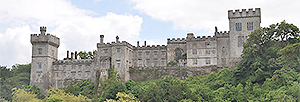The Bolton Abbey Estate
26,100 acres to explore from your caravan in the Yorkshire Dales

Since it was first made accessible to the public by the 6th Duke of Devonshire in the early 1800s, generations of families, once fuelled by the Embsay and Bolton Abbey heritage steam railway locomotives, continue to enjoy this unique 26,100 acre pocket of the British countryside.
There are many amenities to enhance a day spent here, including quaint tearooms, individual gift shops and other retailers, secure car parking and a network of accessible pathways to explore the riverside and countryside. Visitors come from far and wide too to enjoy the estate, where flora and fauna are encouraged to thrive. Along with rare plant species and seasonal favourites such as bluebells, heather and wonderful fungi, remarkable animal species such as otter, roe deer, buzzard and kingfisher may also be spotted on a visit to the estate.
With multiple Sites of Scientific Interest, the Bolton Abbey Estate encompasses many natural wonders, from the ancient Strid Wood and the waterfalls in the Valley of Desolation, to the vast areas of heather moorland which come alive with purple hues in the summer.
The history of the Bolton Abbey Estate
The land at Bolton Abbey was gifted to the Augustinian Canons by Lady Alice de Romille of Skipton Castle in 1154. Bolton Priory took around a century to take form and was one of the largest monasteries in England. Building work on the site was still taking place up until the Dissolution of the Monasteries in 1540. The Romille line died out around 1310, and Edward II granted the estates to Robert Clifford, whose descendants married into the Cavendish family, the future Dukes of Devonshire. The estate is now in trust for the Chatsworth Settlement Trustees to steward.
Today, the 26,100 acre estate contains four areas designated as Sites of Special Scientific Interest, including Strid Wood, an ancient woodland, which contains the length of the River Wharfe known as The Strid, and a marine fossil quarry. The estate encompasses 5 miles of river, a wealth of farms and buildings of architectural interest, and four Grade I listed buildings. The iconic stepping stones cross the River Wharfe near the Priory ruins and were the Augustinian Canons' ancient right of way.
Walking & Wildlife on the Estate
Bolton Abbey offers an array of trails and tracks, for visitors to enjoy, whether it be a gentle stroll or moorland hike, this estate has it all, providing something for all walking abilities.
With 80 miles of well-maintained paths, there is the opportunity to enjoy every aspect of Bolton Abbey year-round. The walks are detailed on our visitor map.
Our walks offer the opportunity to enjoy the fabulous wildlife we have at Bolton Abbey, described as “one of the finest wildlife habitats for miles around, the array of species that can be seen and enjoyed is magnificent.” Lucky visitors might spot the otters playing in the River Wharfe, the green woodpecker on the east bank or the buzzard soaring over the moors. Our bird life is abundant, from Merlins to Short Eared Owls plus a variety of endangered waders including the elusive Curlew.
If you’d like to spend more time enjoying this beautiful estate, Beamsley Mill Holiday Homes could be the perfect location for your countryside bolthole.






